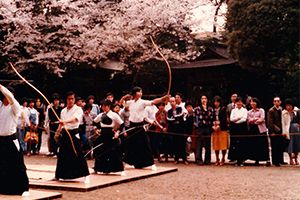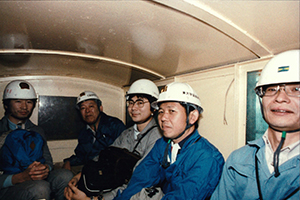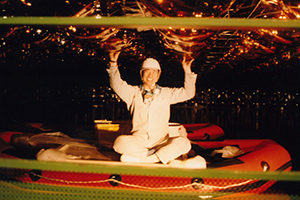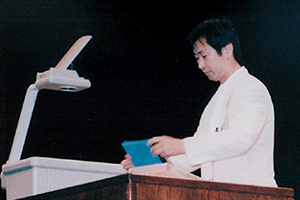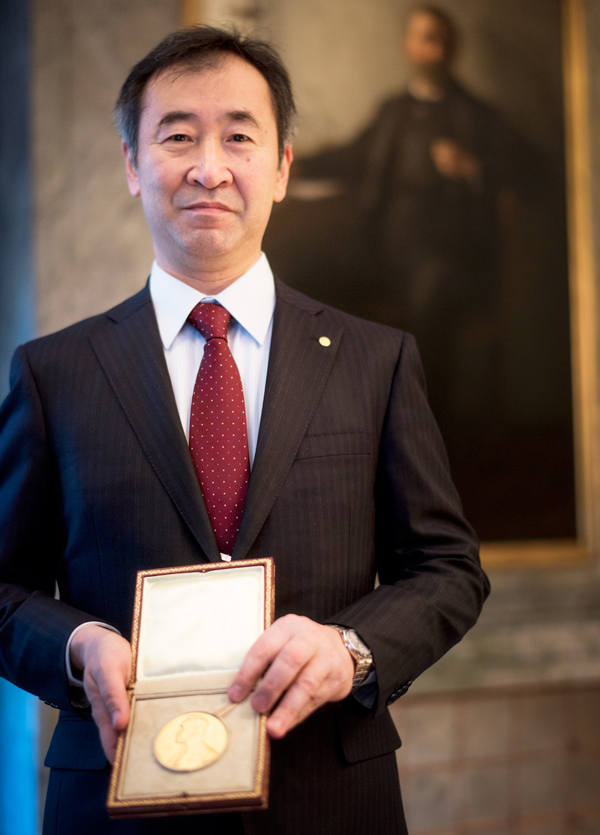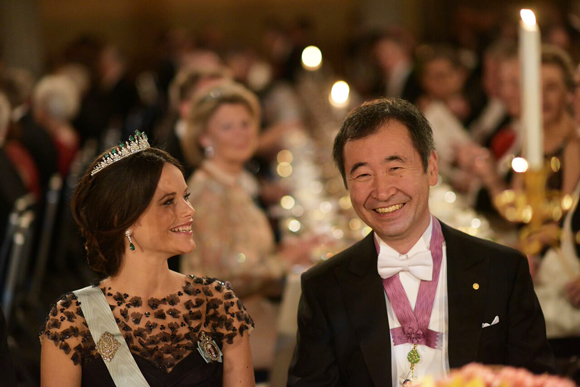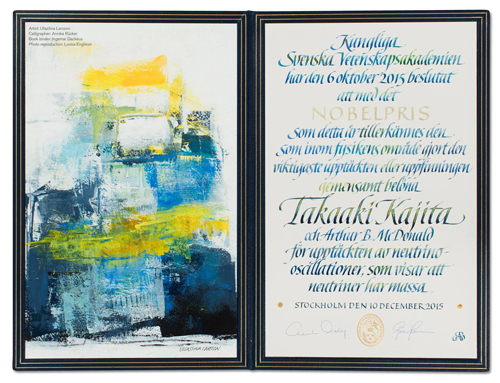Why Professor Takaaki Kajita received the Nobel Prize in Physics: The Discovery of Neutrino Oscillations, which Shows that Neutrinos have Mass
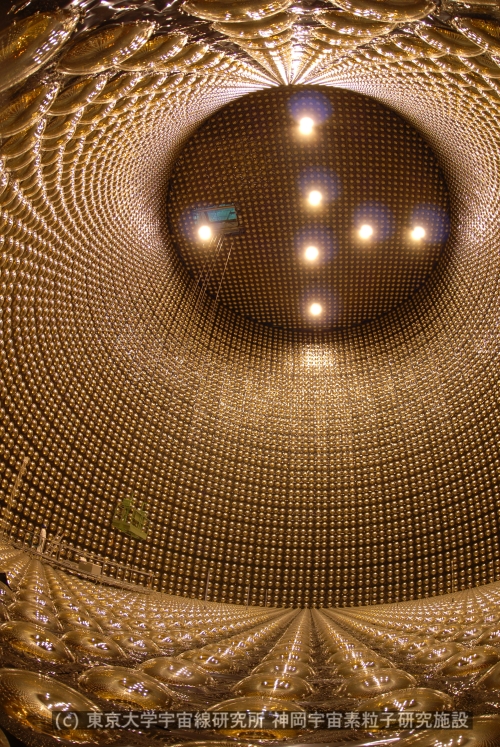
© Kamioka Observatory, ICRR
Particles called atmospheric neutrinos are created when radioactive rays descending from outer space come into contact with particles in the Earth's atmosphere. Using the Super-Kamiokande detector, Professor Kajita revealed that muon neutrinos, which are types of atmospheric neutrinos, change when in flight. Meanwhile, Professor McDonald's research at Canada's Sudbury Neutrino Observatory showed that electron neutrinos, which are a subset of solar neutrinos and fly to Earth from the Sun, change in a similar manner. Both discoveries transcended the existing conventional theories that neutrinos do not have mass, and paved the way towards a new horizon in the world of particle physics.
The Super-Kamiokande is a neutrino-observing facility located 1000 meters underground in Hida City, Gifu Prefecture. Its cylindrical water tank, which holds 50,000 tons of ultrapure water, measures nearly 40 meters in diameter and height, and its inner walls are lined with approximately 11,000 photo-sensors. When neutrinos enter the Super-Kamiokande detector, they occasionally collide with water molecules and change into electron and muon particles, emitting a ring-shaped light called "Cherenkov light." By detecting that light with the sensors, it is possible to determine the neutrinos' characteristics, such as their directions, types, and energy amounts.
Atmospheric neutrinos can appear anywhere in the Earth's atmosphere. Neutrinos only rarely collide with other particles, so atmospheric neutrinos created on the opposite side of the Earth can pass through the Super-Kamiokande detector without being stopped part of the way through. Therefore, the Super-Kamiokande detector can observe atmospheric neutrinos coming from all directions.
In 1998, Professor Kajita and other members of the Super-Kamiokande Group discovered from their observations of atmospheric neutrinos that the number of neutrinos made on the opposite side of the Earth that had flown the long distance to the Super-Kamiokande detector was only about half as high as the number of neutrinos that came down from directly above the detector.
This discrepancy in numbers was due to "neutrino oscillation," a phenomenon in which neutrinos change into other types of neutrinos while in flight. As the muon neutrinos created on the opposite side of the Earth passed through the Earth's interior, they transformed into tau neutrinos, which is why observations showed fewer muon neutrinos than expected.
Neutrino oscillation is a phenomenon that occurs only when neutrinos have mass. Therefore, the discovery of neutrino oscillations became definitive proof that neutrinos have a mass that is not zero.
What Exactly are Neutrinos?
A neutrino is a type of elementary particle. Elementary particles are particles are broken down into such minuscule pieces that they that cannot be broken down any further and thus become the fundamental building blocks of matter. Neutrinos, however, are types of elementary particles that differ somewhat from the elementary particles that compose our bodies and the matter around us. Let's take a peek into the properties of the mysterious neutrino.
Property 1 : Ghost-like particles
Neutrinos are extremely light and do not hold a charge, so they do not interact with most other elementary particles. This characteristic enables them to pass through everything and travel out to the far reaches of outer space. Since they can also easily pass through detectors, observing them has been an incredibly difficult task. The Super-Kamiokande detector therefore uses a large volume of water to observe the rare instances in which neutrinos collide with water.
Property 2 : Created in a variety of places
Neutrinos pass through everything, and there is an incredibly large amount of them. For instance, over several trillion neutrinos are passing through the palms of your hands every second! Neutrinos originate from a variety of places, such as the Earth's atmosphere, inside the Sun and other stars, supernovas, and the beginning of space, the Big Bang. Neutrinos can also be artificially made by using a particle accelerator.
Property 3 : Three siblings
Neutrinos are related to electrons (however, they differ from electrons in that they do not hold an electric charge). As they are paired with electrons and the "siblings" of electrons, muons and tau particles, there are also three types of neutrinos: electron neutrinos, muon neutrinos and tau neutrinos. (The terms "muon" and "tau" come from the Greek letters meu [μ] and tau [τ].)
Property 4 : Very, very light
The mass of a neutrino is less than 1/1,000,000th of that of an electron. If you liken the weight of an electron to that of an elephant, the weight of a neutrino would come out to be lighter than a one yen coin. The mass of neutrinos was long thought to be zero, and this theory had been accepted as a fact of the Standard Model of particle physics until the discovery of neutrino oscillations.
Property 5 : They repeatedly transform
While in flight, neutrinos repeatedly change into different types of neutrinos and then return to their original forms, like chocolate ice cream becoming strawberry ice cream and then changing back into chocolate ice cream. This phenomenon is called neutrino oscillation. The term "oscillation" refers to moving between two points, like a pendulum.
Bonus : "Little Neutral One"
The word "neutrino" is a combination of the Italian word "neutro," which means "neutral or electrically neutral," and the diminutive suffix "-ino." Literally translated, "neutrino" would mean something like "little neutral one."
Why does oscillation mean that neutrinos have mass?
Timeline of Neutrino Research and the Life of Professor Takaaki Kajita
| ―Timeline of Neutrino Research ―Life of Professor Takaaki Kajita ―Milestone Events | |
| 1930 | Ghostlike particles are postulated by Austrian theoretical physicist Wolfgang Pauli |
| 1933 | Italian physicist Enrico Fermi names these ghostlike particles "neutrinos" |
| 1956 | Frederick Reines and other scientists in the United States detect neutrinos for the first time (created in a nuclear reactor) |
| Mar 9, 1959 |
Takaaki Kajita is born in Higashimatsuyama City, Saitama Prefecture |
| the 1970s | American scientist Raymond Davis, Jr. observes neutrinos coming from the Sun |
| 1977 | Takaaki Kajita graduates from Saitama Prefectural Kawagoe High School |
| 1981 | Takaaki Kajita graduates from the Department of Physics, School of Science of Saitama University. He enters Professor Masatoshi Koshiba's laboratory in the University of Tokyo Graduate School of Science and participates in the Kamiokande experiments |
| 1983 | Takaaki Kajita completes his Master's degree program in physics at the University of Tokyo Graduate School of Science's Department of Physics |
| 1986 | Takaaki Kajita completes his Doctoral degree program in physics at the University of Tokyo Graduate School of Science's Department of Physics. He receives his PhD for research in proton decay |
| 1986 | Takaaki Kajita becomes a research assistant at the International Center for Elementary Particle Physics of the University of Tokyo's Faculty of Science. He notices the first signs of neutrino oscillation around autumn |
| 1987 | The Kamiokande Group observes neutrinos from a supernova explosion |
| 1988 | Takaaki Kajita becomes a research assistant at the University of Tokyo's Institute for Cosmic Ray Research. He publishes his first paper on atmospheric neutrinos |
| 1992 | Takaaki Kajita becomes an associate professor at the University of Tokyo's Institute for Cosmic Ray Research |
| 1996 | Observations commence at the Super-Kamiokande facility |
| Jun 1998 |
Takaaki Kajita announces at the International Conference on Neutrino Physics and Astrophysics (Takayama City, Gifu Prefecture) that neutrinos have mass |
| Sept 1999 |
Takaaki Kajita becomes a professor at the University of Tokyo's Institute for Cosmic Ray Research |
| Apr 1999 |
Takaaki Kajita becomes the director of the Research Center for Cosmic Neutrino of the University of Tokyo's Institute for Cosmic Ray Research |
| Nov 2001 |
Major accident occurs in which over half of the Super-Kamiokande's photomultiplier tubes break |
| Dec 2002 |
Professor Emeritus Masatoshi Koshiba receives the Nobel Prize in Physics |
| 2006 | The Super-Kamiokande is fully repaired |
| Apr 2008 |
Takaaki Kajita becomes director of the University of Tokyo Institute for Cosmic Ray Research (current position) |
| 2010 | Takaaki Kajita is awarded the Yoji Totsuka Memorial Prize |
| 2012 | Takaaki Kajita is awarded the Japan Academy Prize |
| Nov 2015 |
Takaaki Kajita receives the Award for Cultural Merit and the Breakthrough Prize in Particle Physics. He publishes his first book |
| Dec 2015 |
Takaaki Kajita receives the Nobel Prize in Physics |
